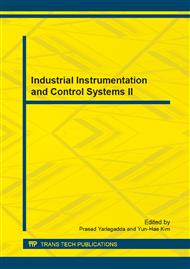[1]
IF. Akyildiz, WY. Lee, MC. Vuran and S. Mohanty: Next generation/dynamic spectrum access/cognitive radio wireless networks: a survey. Computer Networks. vol. 50(2) (2006), pp.2127-2159.
DOI: 10.1016/j.comnet.2006.05.001
Google Scholar
[2]
A. Goldsmith, SA. Jafar, I Marić and Srinivasa S: Breaking spectrum gridlock with cognitive radios: an Information theoretic perspective. Proceedings of the IEEE. vol. 97(5) (2009), pp.894-914.
DOI: 10.1109/jproc.2009.2015717
Google Scholar
[3]
R. W. Pabst and B. H. Shultz: Relay-based deployment concepts for wireless and mobile broadband radio, IEEE Communications Magazine. vol. 42(9) (2004), pp.80-89.
DOI: 10.1109/mcom.2004.1336724
Google Scholar
[4]
Q. Zhang, JC. Jia and J. Zhang: Cooperative relay to improve diversity in cognitive radio networks, IEEE Communications Magazine. vol. 47(2) (2009), pp.111-117.
DOI: 10.1109/mcom.2009.4785388
Google Scholar
[5]
YL. Zou, YD. Yao and BY. Zheng: Cooperative relay techniques for cognitive radio systems: Spectrum sensing and secondary user transmissions, IEEE Communications Magazine. vol. 50(4) (2012), pp.98-103.
DOI: 10.1109/mcom.2012.6178840
Google Scholar
[6]
YL. Zou, J. Zhu, BY Zheng and YD. Yao: An adaptive cooperation diversity scheme with best-relay selection in cognitive radio networks, IEEE Trans. Signal Process. vol. 58(10) (2010), pp.5438-5445.
DOI: 10.1109/tsp.2010.2053708
Google Scholar
[7]
P. Popovski and H. Yomo: Bi-directional amplification of throughput in a wireless multi-hop network. In Proc. IEEE VTC, Melbourne, Australia. (2006); pp.588-593, 7-10.
DOI: 10.1109/vetecs.2006.1682892
Google Scholar
[8]
Boris Rankov and Armin Wittneben: Spectral efficient protocols for half-duplex fading relay channels. IEEE Journal on Selected Areas in Communications 2007. vol. 25(2) (2007), pp.379-389.
DOI: 10.1109/jsac.2007.070213
Google Scholar
[9]
Q. Li, SH. Ting, A. Pandharipande and Y. Han: Cognitive spectrum sharing with two-way relaying systems. IEEE Transactions on Vehicular Technology. vol. 60(3) (2011): pp.1233-1240.
DOI: 10.1109/tvt.2010.2104334
Google Scholar
[10]
M. Hafeez and J.M.H. Elmirghani: Analysis of dynamic spectrum leasing for coded bi-directional communication. IEEE Journal on Selected Areas in Communications. vol. 30(8) (2012), pp.1500-1512.
DOI: 10.1109/jsac.2012.120918
Google Scholar
[11]
P. Ubaidulla and S. Aissa: Optimal relay selection and power allocation for cognitive two-way relaying networks. IEEE Wireless Communications Letters. vol. 1(3) (2012), pp.225-228.
DOI: 10.1109/wcl.2012.032312.120095
Google Scholar
[12]
Q. Li, SH. Ting, A. Pandharipande and Y. Han: Adaptive two-way relaying and outage analysis. IEEE Transactions on Wireless Communications. vol. 8(6) (2009), pp.3288-3299.
DOI: 10.1109/twc.2009.081213
Google Scholar
[13]
R. Ahlswede, N. Cai and SYR. Li: Network information flow. IEEE Transactions on Information Theory. vol. 46(4) (2000), pp.1204-1216.
DOI: 10.1109/18.850663
Google Scholar
[14]
YL. Zou, YD. Yao and BY. Zheng: Cognitive transmissions with multiple relays in cognitive radio networks, IEEE Trans. Wireless Commun. vol. 10(2) (2011), pp.648-659.
DOI: 10.1109/twc.2010.120610.100830
Google Scholar


